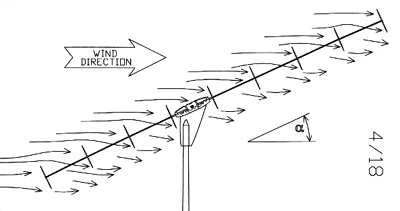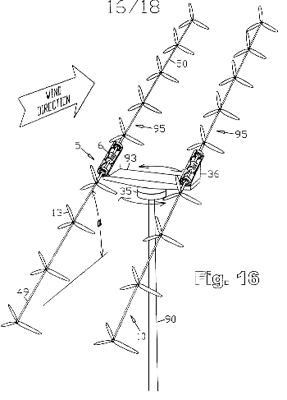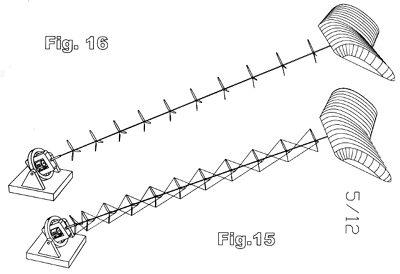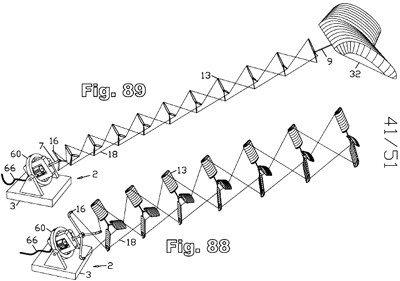
Any slight losses of power from wind shadow effects are more than made up for by the overwhelming combined power of a multiplicity of rotors.
Q1. Doesn't the wind shadow from one rotor inhibit the next rotor from getting wind?
A: That's definitely a factor to consider. Our driveshaft is at an angle
from
horizontal, with the nose pointing slightly downward so that, with proper
spacing, each
rotor gets its own wind. In addition, the forward tilt of the rotors
tends to direct
the wind downward, pulling more fresh wind through the machine from above...

Any slight losses of power from wind shadow effects are more than made up for
by the
overwhelming combined power of a multiplicity of rotors.

|
Q2. Can two or more of the Selsam Multi-Rotor Wind Turbines be combined
on a
rotating frame to form a single self-aiming wind-power-production structure?
A: Yes. Multiple turbines mounted to a single rotating armature are self-aiming as a combined unit. Multiple levels are also possible. Q3. Is the Selsam Multi-rotor wind turbine well suited for rooftop mounting? A: Yes! The low profile design makes good use of the flow of air over a roof. The multiple rotors combine for smooth, quiet, relatively vibration- free operation. |
Q4. What about the fact that the horizontal axis rotors aren't aimed exactly into the wind, but instead are aimed slightly downward from horizontal? Don't they lose a lot of power?
A: Another good point. Luckily, a slight deviation from the wind direction has almost no effect on a rotor's performance. The offset angle can also be in another plane, such as horizontal, useful in larger installations where rotor size is a significant fraction of tower height.
Q5. What about the bearings? Isn't there a lot of radial loading from the weight and wind loading amplified by the leverage of the length of the shaft?
A: The upwind section of the shaft approximately balances the downwind section. This minimizes radial loading on the bearings. That allows long bearing life.
Q6: Why doesn't it need a tail, or a dedicated azimuthal orientation means of any kind?
A: We feel that since a tail doesn't contribute any power, get rid of it and put on something that does produce power, like more rotors. A conventional tail is like a partner on a tandem bike who refuses to pedal! We simply place the center of aerodynamic drag of the entire driveshaft with its attached rotors slightly downwind of an azimuthal pivot point, and the machine will faithfully stay headed windward.
Q7: What about protection in high winds?
A: Several factors act to protect the machine in high winds: First, at the higher reynolds numbers that come with increasing wind speeds, the length of wind shadows effectively increases, so that upwind rotors will begin to protect downwind rotors. More importantly, the downwind section of the shaft will tend to bend to a more horizontal direction, placing downwind rotors more into the wind shadows of the upwind ones. Finally, the generator and shaft can be resiliently mounted, so that they are blown into a more horizontal orientation by very strong winds, so that overall rotor exposure is reduced, while power output and rpm are maintained. They key to proper behavior at all wind speeds is that progressively more rotor surface is exposed in low winds, and less in high winds. No furling cycle is involved, so there is never a time when no power is generated because of excessively strong winds. The action is also not as radical as furling, and is less prone to "finicky" behavior.
Q8: What designs do you have in mind for the future? Are they also covered by your patents pending?
A: Yes, and the future is wide open. This design is an important
advance,
yet is still just the tip of the iceberg. Future patent pending designs
include
atmospherically buoyant versions that incorporate helium-filled or
hydrogen-filled
kite-like aerodynamic lifting bodies instead of a tower. Others utilize
buoyant,
inflated rotors. We have much more advanced designs still. We have had
preliminary
discussions with some NASA personnel indicating that such turbines might find
use as
easily deployable power sources on Mars.


Q9: Despite all the logical reasons why this new design seems to be a step forward, I'm having trouble accepting it. It seems too simple or something - I can't quite put my finger on it, but it bothers me. Is there any help for someone like me?
A: Innovative designs are often surprisingly simple. Advances in materials science make such progressive designs more practical. Progress inevitably involves change. Just close your eyes and relax, and keep repeating this mantra: "More rotors mean more power".
Q10: Utility-sized Turbines are being made larger all the time. Will yours scale up to Megawatt sizes?
A: So far they are scaling up beautifully. They are surprisingly stable even in very strong winds. We don't see any upper limit yet - further experiments will tell us how big they can get. For a given power rating, say 1 megawatt, our rotors are much smaller, about 1/3 of the diameter or less, and weighing a total of only about a third as much, collectively, with 2/3 less angular momentum. Blade stress considerations would thus be reduced, for a given power rating, using our design. This would suggest that the upper size limit for this design could also be in the megawatt range, and for atmospherically buoyant versions, possibly higher.
Q11: The trend has been going toward low speed, high torque alternators and generators.
A: Only because there hasn't been any other choice, except using a power-robbing, maintenance and wear-prone, heavy, expensive gearbox. By comparison a specially-built, multipole generator designed for low speed, high-torque generator has indeed been an attractive, albeit initially expensive alternative, but a generator made for normal speeds is still preferable, if there is a choice. There's a reason generators have traditionally been made for a faster RPM, given a choice. They can be smaller, and lighter, and simpler, by just turning faster. Also, at a faster RPM, the same power is transmitted at less torque, so the drivetrain can be less robust. The result is a lighter, simpler, more economical installation. When this new design is scaled up, we, too will preferentially take advantage of specially built, multipole generators with many poles for slow, high-torque operation. Our design, however, can be more powerful before it reaches a size where such a specially-built low speed generator is needed.
Questions to ask yourself:
How many wheels does your car have?
Not just one? What about trucks?
How many cylinders in your engine?
More cylinders run smoother - and have more surface area per unit mass.
How many cars in a train? Not just one? Why?
It's much easier on the track. Economy of scale - repeating units...
How many sails on a clipper ship? Not just one? Why not?
How many tiles around your bathtub? Not just one huge thick tile?
Better
surface to volume ratio with multiple small tiles? Just checking...
How many tiles on your roof? Not just one big, thick tile? Better
surface area
to mass ratio with multiple smaller, thinner tiles? I see.
Why do we look up and see a flock of geese, rather than just one giant goose?
(run!) Why
do ostriches and all other birds over a certain size have to walk everywhere?
How many engines on a large airplane? How many props? Why not just
one big
prop?
How many loops of wire in a generator? Not just one? Why not?
More
power?
How many fingers do you have? How many Toes? How many teeth?
How many leaves on a plant?
Now how many rotors should a wind turbine have?